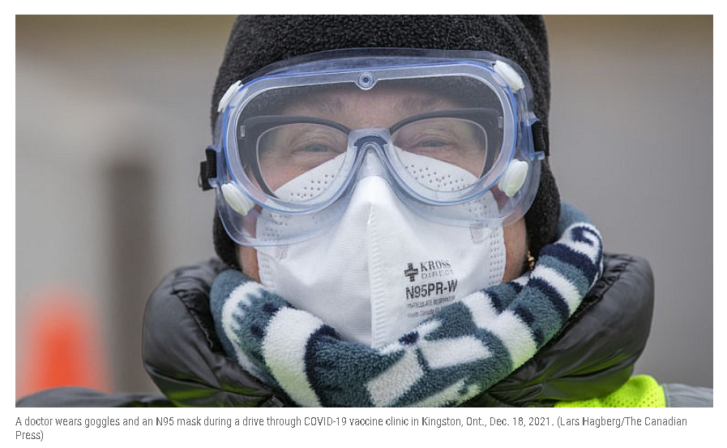It’s easier for the virus to move through surgical or cloth masks, experts say, while respirators filter tiny aerosols
On Sunday, Dr. Theresa Tam, Canada’s chief public health officer, quietly arrived at the “Jabapalooza” vaccine clinic in her Ottawa neighbourhood to get her third dose. Noticeably, she was wearing a white respirator mask in the indoor public space, something she emphasized the next day as she swapped her old Twitter profile photo featuring her in a surgical mask for one taken at that community-run clinic. She tweeted: “If you’re like me there is so much to do in a day that you haven’t updated your profile pic in some time, but in real life you’ve upped your mask game and practice #COVIDWise 24/7 because #omicron.”
Tam is one of a growing number of health care professionals who are using their social media profile pictures to send a message that N95-quality respirator masks have become an essential part of personal protection against COVID-19 for everyone, not only for those working in high-risk settings such as hospitals. Even the U.S. Centers for Disease Control and Prevention is considering updating its own mask guidance to recommend the public wear N95-quality masks, the Washington Post reports.

The upshot: People need to improve their mask game—surgical and cloth masks just aren’t up for the battle with an airborne nemesis such as Omicron.
The problem with surgical and cloth masks is that the filtering and fit aren’t as good as N95-equivalents. “It’s easier for the aerosol to move through,” says Marina Freire-Gormaly, an expert in aerosol transmission in the department of mechanical engineering at York University. “And there’s a problem in getting a seal around the mask.” The federal government’s online comparison between respirators and surgical masks says that while surgical masks are a barrier to splashes, droplets and spit, they are not designed to seal tight against the face and do not effectively filter small particles from the air.
In contrast, when wearing a N95-type respirator, a user breathes through the fabric of the mask itself, without air escaping through gaps around the edges, such as near the nose or under the chin. The tight-fitting respirators, with their layers of synthetic material, are tested to ensure they filter aerosols to a specific standard (N95s filter 95 per cent of aerosol droplets 0.3 microns in diameter, explains the Canadian Centre for Occupational Health and Safety).
N95-like respirators include N95 (United States), KN95 (China), KF94 (South Korea), FFP2 or FFP3 (Europe) and PFE95 (Canada). People shouldn’t use respirators that include valves, which allow users to potentially breathe out infectious aerosols, Freire-Gormaly explains.
Freire-Gormaly and others suggest trying a few styles to find one that fits your face. “They may feel uncomfortable at first, but will become normal,” she says. If your mask of choice has ear loops rather than straps (which go around the head and tend to offer a tighter fit), consider buying an “ear saver” that attaches to the mask’s loops and goes behind the head, taking pressure off the ears. (I bought my ear saver at a dollar store for $1.50 and have worn my KN95 for up to five hours at a time without discomfort.)
Though N95-like masks cost more than surgical ones, experts say they can be used for up to around 40 hours, which is much longer than indicated on the packaging, as long as they stay in good shape. Since any virus on the surface of a mask won’t survive after three days, Dr. Peter Tsai, who invented the spun material in N95 masks, devised a simple system which he wrote about in The Journal of Emergency Medicine: he uses three or four masks in rotation over the same number of days, hanging each in a dry area until needed again.
Freire-Gormaly has been wearing a KN95 mask in indoor public venues since the start of the pandemic 22 months ago. “Science was demonstrating that aerosols were the way COVID was spreading,” she says. The masks offer “extra peace of mind,” she says, and mean she can go into public spaces such as grocery stores and not “feel extra anxiety when someone sneezes or coughs.”
Freire-Gormaly’s research team is currently examining how particles and aerosols move around the room, depending on how people breathe and cough and how the HVAC system is set up. Using simulations involving an infected “index patient,” they measure the risks of exposure to others. The experiments mimic life without masks, because “eventually, we’re going to take our masks off,” she says. And that means needing to know how to better design spaces that minimize the risk of transmission. Until then, the respirators stay on.
Article From: Maclean’s
Author: Patricia Treble

